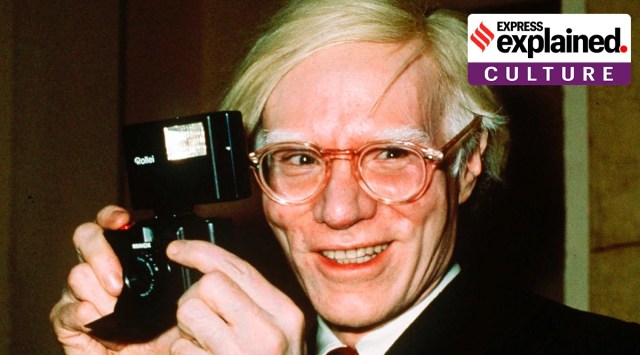Explained: What was revolutionary about Andy Warhol’s art, on whose life a new docu-series on Netflix is based?
Andy Warhol was part of the pop art movement, which began in Britain in the 1950s and involved making art inspired by things we find in popular culture. It rejects ideas of art being fine, elite or academic.
 In this 1976 file photo, pop artist Andy Warhol smiles in New York. (AP Photo)
In this 1976 file photo, pop artist Andy Warhol smiles in New York. (AP Photo)A new docuseries on Netflix revisits an artist who revolutionised art and art production, in America and beyond. The Andy Warhol Diaries, produced by Ryan Murphy and directed by Andrew Rossi, draws from the posthumously published memoirs of Andy Warhol (1928-1987). Enigmatic, pathbreaking and daring—Warhol was all this and much more.
🗞️ Subscribe Now: Get Express Premium to access the best Election reporting and analysis 🗞️
What was revolutionary about Warhol’s art?
Warhol was part of the pop art movement, which began in Britain in the 1950s and involved making art inspired by things we find in popular culture. It rejects ideas of art being fine, elite or academic. As a leading figure of this movement, Warhol turned a lot of heads and raised a lot of eyebrows in 1961, when he created his first pop paintings. Coca-cola [2] was a black and grey composition with a hand-printed “portrait” of the distinctive bottle of the beverage. The method by which he made some of his art, silkscreen prints as opposed to painting, also is revolutionary. Painting demands that there is one original, while print means there can be dozens or hundreds of replicas.
In what other ways did Warhol turn pop culture into art?
Warhol found his muses in objects that we would typically think are banal, such as soup cans and soap pads. Gallery owner and interior designer Muriel Latow gave Warhol the idea of painting soup cans, and objects that people used daily. Warhol went on to make a number of Campbell Soup works, featuring different soup flavours in cans, such as tomato and black bean. For the audience of that time, and even now, this was a departure from art that had otherwise shown “important” subjects. Over the years, Warhol’s art came to be seen as a comment on the commodification of modern, industrial life in the 20th century and a consumerist culture.
Did Warhol find inspiration only in supermarket products?
No, not at all. Warhol’s other famous works include Mona Lisa, in which he replicated the original by Leonardo da Vinci in two different ways. There was a Coloured Mona Lisa, made by replicating the image taken from a brochure published by the Metropolitan Museum of Art. Warhol was looking at the commodification of images and icons, and how populations “consume” them. In another work, Gold Marilyn Monroe, Warhol placed a coloured print of the titular actor against a large golden background, much like Byzantine icons. This was made after Monroe’s tragic death—the actor had died by overdosing on sleeping pills—and the artwork was to suggest tragedy, the manner in which audiences commodify actors, and the veneration of icons and sex symbols such as Monroe.
Did Warhol make only prints?
Warhol has often been called a Renaissance Man. He made a lot more than only prints. He made several films, television series and videos, and made even more photographs. His most popular and acclaimed film was Chelsea Girls. He also wrote books, such as a: A Novel, which contained audio recordings of Warhol and his friends, with spelling errors and mumbling. Warhol was also an important part of the 1960s music scene, adopting the band Velvet Underground. The Andy Warhol Diaries, which were published posthumously in 1989, was dictated over phone calls to his friend and collaborator, Pat Hackett, who would later type out the diary pages.
What was Warhol’s personal style like?
As unconventional as his art and artistic tastes were, Warhol was equally so with his public persona. His signature silver wig, leather jackets, monochrome suits (unlike his colourful art), and his love for glasses was part of the Warholian aesthetic.
Newsletter | Click to get the day’s best explainers in your inbox
- 01
- 02
- 03
- 04
- 05







































